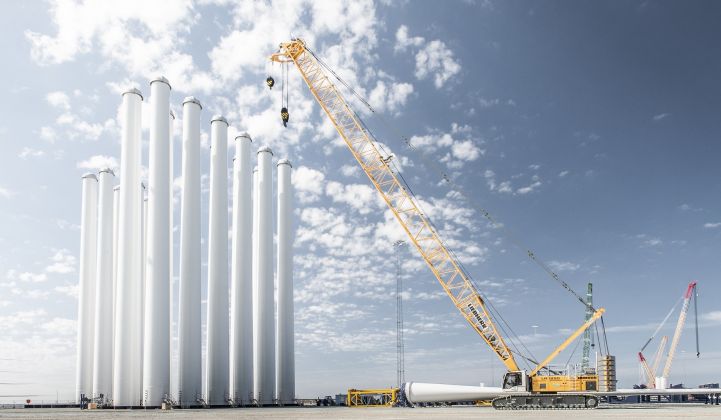The delay to Vineyard Wind’s Massachusetts offshore wind project has meant logistical migraines for the companies involved and uncertainty over the timing of the U.S. market’s long-awaited liftoff.
One possible upside? The additional scrutiny makes it less likely that Vineyard or other future projects will be brought to their knees by endless lawsuits, like Cape Wind was earlier this decade.
On the cusp of blossoming into a multi-gigawatt annual market along the East Coast, the U.S. offshore wind industry remains deeply frustrated by the Interior Department’s unexpected decision this summer to impose additional “cumulative impacts” studies on Vineyard’s project.
The 800-megawatt wind farm was due for completion in two phases in 2021-2022 south of Martha’s Vineyard, transforming a market with just 30 megawatts installed. But that timeline now looks out of reach even if the project were approved today, complicating the developer’s qualification plan for the fading federal Investment Tax Credit.
Many in the offshore wind business remain skeptical about the government’s intentions in slowing down a $2.8 billion project that would have given birth to a new renewable energy industry on American shores. The delay came a few months after David Bernhardt, a former oil industry lobbyist, was named Secretary of the Interior.
Other experts, however, say there may be perfectly legitimate reasons for the additional studies from the Bureau of Ocean Energy Management (BOEM) and that the delay may ultimately benefit a market with an ill-starred history in U.S. waters and ongoing tensions with other maritime industries.
“There’s this camp that says this is oil and gas driven” or that “malicious intent” is behind the delay, said Spencer Hunsberger, managing director at Credit Suisse, where he runs the energy asset finance business. “I would disagree with that.”
Speaking two weeks ago at an industry event hosted by FTI Consulting in New York, Hunsberger noted that BOEM has not yet breached the two-year permitting window given by President Donald Trump to federal agencies to complete their environmental reviews for major infrastructure projects.
In discussions with people close to the project, “They’re saying, ‘Look, this is an agency [BOEM] that’s frankly overwhelmed with the amount of work that it’s being asked to do on the pace of submissions right now,’” Hunsberger said.
“They don’t want to set themselves up for a lawsuit or some sort of dispute down the line. They want to get it right, and they’re taking the time to do that.”
Douglas Schultz, head of origination at the Department of Energy’s loans program office, agreed with that interpretation of events.
“If you read the history of Cape Wind, it was all about permitting,” said Schultz, referring to the pioneering project off Massachusetts’ Cape Cod that ultimately collapsed under a barrage of lawsuits.
“There was ongoing litigation on every front, and it just kept going on and on and on, until they finally just couldn’t go any further. That’s what we don’t want to happen here.”
Schultz is not involved with Vineyard’s permitting, he noted. The DOE has loaned tens of billions of dollars to U.S. renewables projects over the past decade or so.
“What we’ve seen in the [environmental] reviews that all the various agencies have to do is they’re very worried about litigation risk,” Schultz explained.
“What they’re really worried about is getting into a situation where they approve something, it starts construction, and then there’s litigation. This is a tactic that a lot of entities will use to try to stop construction in the middle.”
Agencies like BOEM “want to try to make sure that if there are issues that are raised, and they feel like they’re legitimate, that they’re dealt with,” Schultz said.
Seen in that light, the studies being done on Vineyard’s project could benefit future offshore wind farms by helping to pave the regulatory trail.
A number of big offshore wind farms are supposed to follow closely in Vineyard’s wake, from Ørsted’s South Fork and Revolution projects, due online in 2022-2023, to Equinor’s Empire Wind, due for completion in 2024.
Supply chain pain
Meanwhile, the delay is reverberating up and down the transatlantic supply chain.
Last month Sif, the Netherlands-based steel fabricator that won the contract to make the 84 monopile foundations for the project, said it was discussing "different scenarios" with Vineyard, ranging from "full delay of the project" to manufacturing part of the foundations in 2020.
"Further news on timing is not expected before December 2019," said Sif CEO Fred van Beers, "but with the passing of time it becomes less likely that Vineyard will [begin] production in 2020."
In an earnings call last month, Avangrid said it was pushing U.S. tax authorities to extend its eligibility for the Investment Tax Credit despite the delayed construction schedule.
Avangrid is using the extra time to consider improvements to the project's design, including the potential use of longer rotor blades with the planned 9.5-megawatt MHI Vestas turbines.




